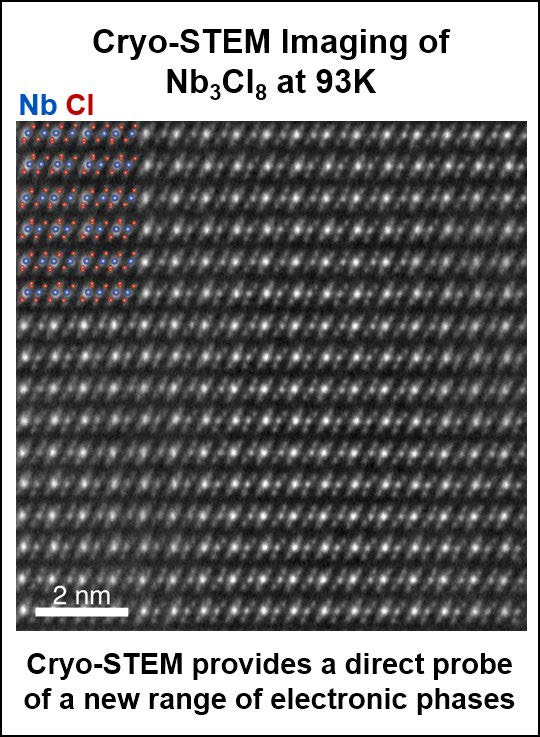High-Resolution Electron Microscopy gets Cooler

featured research
Today, sub-angstrom resolution scanning trans-mission electron microscopy (STEM) imaging is routinely achieved. In addition to resolving individual atomic columns in crystals, STEM performed at room temperature can be used to determine their positions with picometer precision which allows us to directly map local properties. Extending the reach of STEM to cryogenic temperatures will enable atomic-scale characterization of systems which were previously inaccessible in the electron microscope, such as electronic phases that emerge at low temperature.

Figure 1: Cryo-STEM imaging of Nb3Cl8 where individual atoms are resolved. Cryo-STEM provides a direct probe of a new range of electronic phases
Here, we have developed a new approach to register a series of STEM images which has been optimized for low signal-to-noise, cryogenic STEM data. Using this technique we have demonstrated the highest resolution cryo-STEM imaging reaching 0.72 Å at 300 keV near liquid nitrogen temperature. To benefit the broader scientific community, all source code and a graphical user interface are freely and publicly available. Our work enables application of the powerful tools of STEM characterization to low-temperature phases of matter, and will additionally be advantageous in registering and reconstructing a broad array of low signal-to-noise STEM datasets.
This high-resolution cryogenic imaging is available to PARADIM users through the PARADIM’s electron microscopy user facility.
Reference: B. Savitzky et al., Ultramicroscopy 191 (2018) 56–65.
Technical details:
Combining multiple fast image acquisitions to mitigate scan noise and drift artifacts has proven essential for picometer precision, quantitative analysis of atomic resolution scanning transmission electron microscopy (STEM) data. For very low signal-to-noise ratio (SNR) image stacks – frequently required for undistorted imaging at liquid nitrogen temperatures – image registration is particularly delicate, and standard approaches may either fail, or produce subtly specious reconstructed lattice images.
We present an approach which effectively registers and averages image stacks which are challenging due to their low-SNR and propensity for unit cell misalignments. Registering all possible image pairs in a multi-image stack leads to significant information surplus. In combination with a simple physical picture of stage drift, this enables identification of incorrect image registrations, and determination of the optimal image shifts from the complete set of relative shifts. We demonstrate the effectiveness of our approach on experimental, cryogenic STEM datasets, highlighting subtle artifacts endemic to low-SNR lattice images and how they can be avoided.
High-SNR average cryo-STEM images with information transfer out to 0.72 Å are achieved for the first time at 300kV with the sample cooled to near liquid nitrogen temperature. High-resolution STEM imaging of samples cooled to liquid nitrogen temperatures opens the possibility of characterizing the atomic structure of electronic materials across phase transitions, of reactive grain boundaries in 2D materials, as well probing processes at solid-liquid interfaces.
CONTACT:
National Science Foundation
Division of Materials Research
2415 Eisenhower Avenue
Alexandria, VA 22314

Any opinions, findings and conclusions or recommendations expressed in this material are those of the author(s) and do not necessarily reflect the views of the National Science Foundation.
SOCIAL:



